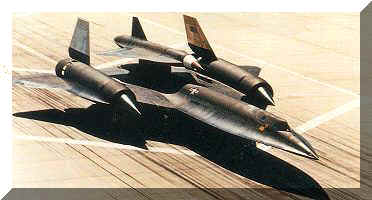
Lockheed M21

Lockheed Skunk Works Classified Project Name: Tagboard
D-21A/B ( Drones)
The Lockheed D-21 unmanned drone was launched at Mach 3 from a pylon mounting on top of the rear fuselage of an A12 Blackbird. The designation of the A12 then became an M21 with the D-21 installed. Two A12's were modified (#60-6940 and #60-6941) to carry the D-21 Drone. In June of 1963 a D-21 was mated to a mother ship for the first time. Actual first flight did not occur until December of 1964. After flying the Photo Reconnaissance mission, the D-21 flew to friendly territory and the camera was ejected from the D-21 Drone. The cameras were recovered in flight by a C-130 mid-air recovery system. The D-21 drone would self-destruct at a low altitude. Kelly Johnson, Lockheed Skunk Works Chief Engineer, cancelled the M21 program when a D-21 was launched into the area behind the cockpit of the M21 resulting in loss of the Launch Control Officer's life and loss of the aircraft. The D-21's then was mated to a B-52H Stratofortress (Project was called Senior Bowl). Five operational missions were flown in this configuration over China. Operations ceased due to political reasons, cost and difficulty of operation. The "Museum of Flight" in Seattle, Washington has the only A-12/Drone display combo in existence.
Construction: Titanium (Beta-120/Ti-13V-11Cr-3A1) Monococque with some composite plastics.
Length: 42 feet, 10 inches
Wingspan: 19 feet, 9 inches
Height: 7 feet, 1/4 inch
Speed: Mach 3.32 (2,200+mph) at 80,000 to 95,000 feet
Maximum Gross Take-off Weight: 11,000 pounds
Operational Ceiling: 95,000 feet
Maximum Unrefueled Range: 3,000 nautical miles
Armament: None
Power Plant Data: Marquardt RJ43-MA-20 Ramjet with 1,500 pounds thrust
D-21 production: 39 drones
D-21A: M-21 launched, 4 launches
D-21B: B-52H launched, 17 Launches, with 5 operational missions
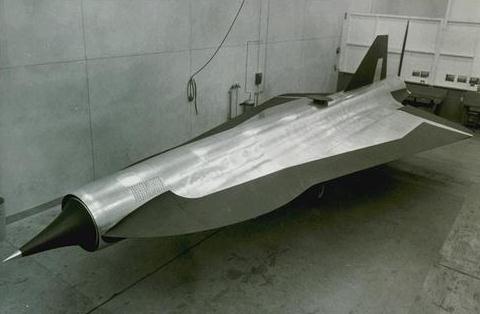
D-21 Drone
(Photos Courtesy of Lockheed Martin Corporation)
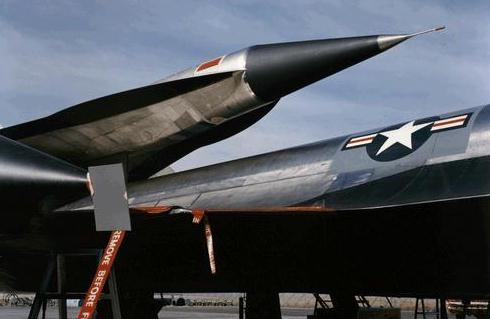
D-21 Serial Numbers
D-21 Family Serial Numbers:
Accurate Model, Design and Series: GTD-21B
Last revised: 24 October, 2019
Model.......Lockheed#......... Launch From.......... Notes
D-21 #501 Modified to D-21B standard. 28 Sept 1967 B-52H accidental drop, no mission flown.
D-21 #502 Static test article - destroyed in ground testing
D-21 #503 Launched from M-12 on 5 March 1966....flew 150 nm. Crew on M-12 was Bill Park and Keith Beswick.
D-21 #504 Launched from M-12 on 30 July 1966. Drone collided with M-12, both destroyed. Lockheed Crew was Bill Park and Ray Torick. Ray was killed but Bill Park survived. This catastrophe ended the M-12 Program.
D-21 #505 Launched from M-12 on 16 June 1966....flew 1,550 nm. Crew was Park/Beswick.
D-21 #506 Launched from M-12 on 27 April 1966....flew 1,120 nm. Crew was Park/Torick.
D-21B #507 Launched from B-52H on 6 Nov 1967.....flew 134 nm.
D-21B #508 Launched from B-52H on 19 Jan 1968....flew 280 nm.
D-21B #509 Launched from B-52H on 2 Dec 1967....flew 1,430 nm
D-21B #510 Modified to D21B standard. On display at Seattle Museum of Flight Mated to an M-12 Airframe.
D-21B #511 Launched from B-52H on 30 April 1968....150 nm.
D-21B #512 Launched from B-52H on 16 June 1968....flew 2,850 nm, no camera carried.
D-21B #513 Listed by D-M as allocated to NASA but remained at D-M in storage. Scrapped in 2013.
D-21B #514 Launched from B-52H on 1 July 1968....flew 80 nm.
D-21B #515 Launched from B-52H on 15 Dec 1968....flew 2,953 nm, Camera recovered, photos-fair.
D-21B #516 Launched from B-52H on 28 Aug 1968....flew 78 nm.
D-21B #517 Launched from B-52H on 9 Nov 1969...1st operational mission, camera not recovered.
D-21B #518 Launched from B-52H on 11 Feb 1969....flew 161 nm.
D-21B #519 Launched from B-52H on 10 May 1969....flew 2,972 nm, camera recovered.
D-21B #520 Launched from B-52H on 10 July 1969....flew 2,937 nm, camera recovered; good photos.
D-21B #521 Launched from B-52H on 20 Feb 1970....flew 2,969 nm, camera recovered; good photos.
D-21B #522 On display at the Pacific Coast Air Museum in Santa Rosa, CA
D-21B #523 Launched from B-52H on 16 Dec 1970....flew 2,448 nm, 2nd operational mission, camera not recovered
D-21B #524 On display at USAF Museum, Wright-Patterson AFB, OH
D-21B #525 On display at Blackbird Airpark, Palmdale, CA
D-21B #526 Launched from B-52H on 4 March 1971....flew 2,935 nm, 3rd operational mission, camera not recovered
D-21B #527 Launched from B-52H on 20 March 1971....flew 2,935 nm, 4th and last operational mission, camera not recovered. D-21 Program closed down. Wreckage recovered and put on display at China Aviation Museum.
D-21B #528 On display at Grissom Air Museum, Grissom ARB, IN
D-21B #529 Was at NASA; returned to AMARC, April 2007. Scrapped in 2013.
D-21B #530 Was on display at Davis Monthan AFB, AZ; in AMARC as of October 10, 2000; believed to be scrapped in 2013.
D-21B #531 Stored at Davis Monthan AFB, AZ in AMARC as of October 10, 2000. Scrapped in 2013.
D-21B #532 Stored at Davis Monthan AFB, AZ in AMARC as of October 10, 2000. Scrapped in 2013.
D-21B #533 On display at Pima Air and Space Museum, Tucson, AZ
D-21B #534 On display at Evergreen Aviation Museum in McMinnville, OR
D-21B #535 Deaccessioned - returned to DRMO. Scrapped in 2013.
D-21B #536 Stored at Davis Monthan AFB, AZ in AMARC as of October 10, 2000. Scrapped in 2013.
D-21B #537 On display at March ARB Museum, April 2007
D-21B #538 Formerly on display at Museum of Aviation, Robins AFB, GA next to an SR-71.
D-21B #539 On display at Beale AFB, CA at Heritage Park next to an SR-71
Notes:
'Launch' is the date the drone was launched. 'From' is the launch platform. 'Notes' include mission length or final disposition. The non-operational missions of 2000+ miles were test missions under operational conditions.

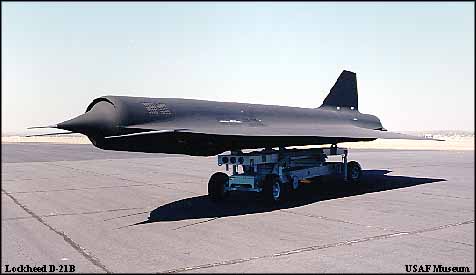
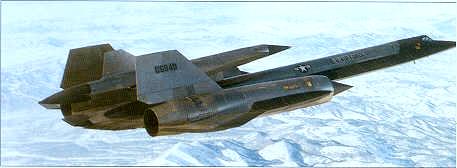
M21 Lockheed Aircraft (A12 mated with D-21A Drone)Project "Senior Bowl"
The mating of the D-21B Drone to the B-52H bomber was one of the most closely guarded secrets of the Blackbird Program. A very in-depth look and Image Archive of the "A" Flight 4200th Support Squadron at Beale AFB in California courtesy of Jim Goodall, Glen Chapman and Jerry Miller at this URL:
http://www.sr71.com/srbowl001.htm
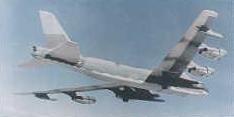
B-52H and D-21B mated together
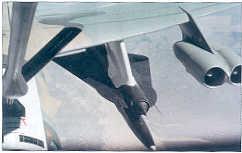
D-21B Prior to Launch From B-52H
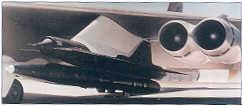
D-21B Ground View

D-21 Launched with Solid Fuel Booster
(Photos Courtesy of Lockheed Martin)D-21 Ramjet Engine Details
Editors Note: I received this e-mail from Jerry Miller who had hands-on experience
working with the D-21 Drone. This information is provided to acquaint students of
Aeronautical Study with the inner workings of the D-21 Ramjet Engine and to correct
the D-21 Engine Model Number.Mr. Haynes:
Thanks for your continuing good work on the preservation of Blackbird history.
I have a special interest in the M/D-21 version and am finding it difficult to correct a continuing, minor error in the Ramjet Engine model number. All current references to this engine identify it as a Marquardt XRJ 43-MA20, the same engine as used on the Bomarc B Interceptor Missile. This is not the case and if possible, I would appreciate your help in spreading this informational fine point. The D-21 engine is properly identified as an XRJ 43-MA20S-4.I have intimate knowledge of these engines and of the previous models from which the D-21 engine derived. The XRJ 43-MA20 was a complete, externally mounted, ramjet engine with a fixed geometry, Mach 2.35, isentropic spike inlet. The engines' integral combustion chamber/exit nozzle was designed for relatively low altitude cruise and therefore did not have a high expansion ratio nozzle. The ignition system was two pyrotechnic flares. There was no re-ignition capability. The fuel control and flame holder combustion limits would not allow operation at high altitudes. The MA20 engine, used on the Bomarc, contained an all pneumatic fuel control that maintained constant Mach Number at two selectable Mach Numbers using pressure signals from the "built in" inlet. This engine could function as an independent external power plant on any vehicle that could reach sufficient speed to cause efficient inlet operation. It was developed in supersonic wind tunnels at Marquardt's Van Nuys, California test facility, flight tested on the Lockheed X-7A3 at Holloman AFB, Alamogordo, NM and deployed operationally on the Bomarc B
The MA20S-4 engine, used in the D-21, used many of the MA20 components, but modified to operate at lower pressures and higher temperatures. The S-4 was immersed in the body of the D-21 and had no inlet structure (because it used the D-21 inlet system). The engine center body and main structure remained, to house the fuel control, fuel pump, fuel injector nozzles and flame holder assembly. The flame holder system was redesigned to allow for stable combustion at extremely high altitude, high temperature and low pressure. Ignition was by TEB (TriEthylBoran) to allow for re-ignition in the event of flameout. The combustion chamber/exit nozzle was redesigned to provide for the much greater expansion ratio required for high altitude cruse. The design also incorporated an ejector system to provide for engine structure cooling.
The pneumatic fuel control computer was modified to function at much lower pressures and higher temperatures. The input pressure signals were modified to accept air data from the D-21 inlet and to maximize full power operation limited only by the D-21 inlet conditions and mission parameters. The fuel flow schedule, pumps, controls and injector nozzles were redesigned to permit accurate flow control and injection at the much lower air flow requirements of extreme high altitude.
If it would be possible to display both of these engines on a dolly, side by side, they would not look at all alike. They have common roots (in the Marquardt RJ43 ramjet family) but the similarity ends there. So far, attempts to display these engines have been stopped by the environmental concerns of some authorities. Much of the center body construction is a Magnesium Thorium alloy. It may not be possible to overcome this caution, but I would like to see such a display as a means to educate aviation enthusiasts about the success of ramjets, as used in the US.
There are a few photographs (some I have given to the Museum of Flight) and some in Lockheed's archives. Perhaps there were some taken by the Air Force at Beale AFB after I trained them to do engine calibrations for the D-21B.
Thanks for caring, write if you can.
Best Regards, Jerry Miller
I received this interesting email from Mike Wood, Lt Col, USAFR:
While
flying the other day, I relayed a story to a coworker about the D21 drone and he
was interested in more details. I did a web search and found your
website. Congrats on an excellent and heartwarming tribute to the SR-71!
I thought you might enjoy the attached photos and background information.
I served as Executive Officer to the C-17 Combined Test Force Commander at
Edwards AFB from approx Aug 92 to Aug 94. During the course of C-17
testing, we were approached by NASA Ames-Dryden with a unique proposal--they
wanted us to rescue several D21 drones from AMARC at Davis Monthan AFB and
return them to Edwards. As I recall, the D21s were slated for destruction
and NASA had been given enough advance warning to make other arrangements before
the chopping block fell.
The C-17 was still very much in the test phase, but the opportunity was a unique
one and we were able to take advantage of the opportunity by using the D21 load
as an "outsized cargo" test, which was a test card that we needed to
run as part of the test program anyhow.
I was one of the planning team members who made arrangements for the trip to
AMARC. As such, I was able to accompany the mission down there and witness
the load and movement of this unique cargo.
The D21s were stored on a cradle-trailer combination that had the unique ability
to rotate the drone as it sat on the cradle, by means of hydraulics. We
took great advantage of that feature, because the wingspan on the D21s made them
too wide to fit through the cargo door of the C-17 unless they were
rotated. When the D21s were rotated to the limit of the cradle-trailer, we
just barely had enough room to fit them through the cargo door on the C-17 at
the opposing top and bottom corners.
The D21s were too long to load up the ramp and straight into the bay, so they
were loaded onto the ramp of the C-17 and chained down in position. After
that, the ramp of the C-17 was lifted so that it was level with the cargo floor,
then the D21s were carefully rolled into the cargo bay.
We airlifted two of the drones out of AMARC with the C-17. After they were
returned to Edwards, they sat down at the NASA Ames-Dryden facility for a bit
while plans for their disposition were worked out. I know that at least
one of them made its way to the Blackbird Airpark in Palmdale, but I don't know
what happened to the other.
The attached photos show the uploaded D21s in the cargo bay of the C-17.
We took a bunch of pictures that day, but I regret that these are the only two I
have. Since the D21 still looked futuristic almost 3 decades after it was
born, we thought the red floodlighting in the cargo bay would make for a
dramatic picture. I regret that I don't have any pictures in normal
lighting to share with you.
You'll see in the photos that the D21s still have their environmental sealants
applied from the Bone yard. All of that was later stripped after their
arrival at Ames-Dryden.
Anyhow, this is just a small bit of D21 history that most folks don't know
about. I thought you might find it interesting and I hope you enjoy the
photos. Feel free to share them on your website--no attribution requested
or necessary.
V/R
Mike Wood, Lt Col, USAFR
Email: woodkc10@aol.com
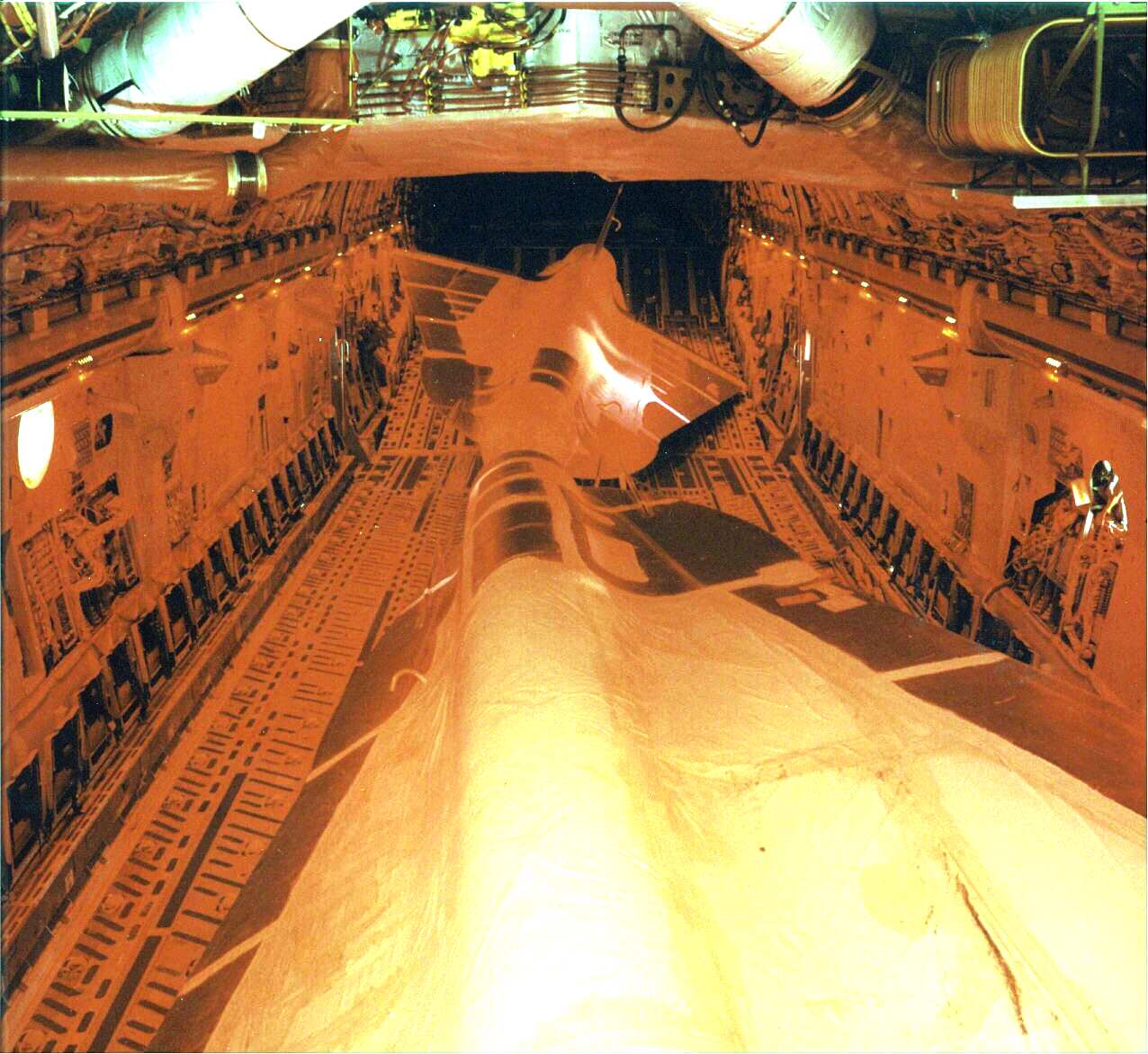
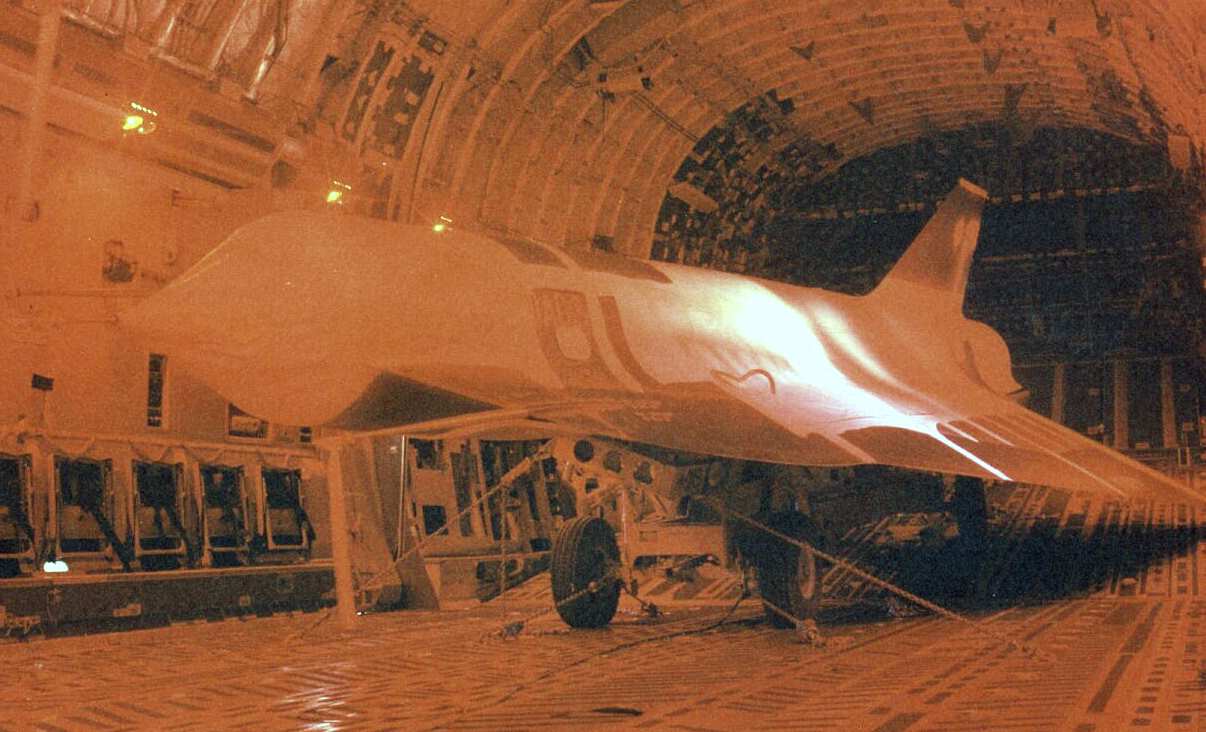
![]() Take
Me to the 4200th Support Squadron D-21B Program
Take
Me to the 4200th Support Squadron D-21B Program
| SR-71 Front Page | Links Page | Index Page | Recollections | 2001 Reunion |
| "SR-71 Blackbirds" Web Site Navigator | ||||
| First Created: April 15, 1996 - Last Revised: October 24, 2019 | ||||
| Copyright © 1996 Leland R. Haynes Email: sr71webmaster@sr71.us | ||||
Photo an11a.jpg belongs to USAF Museum. Image d21-100 and d21-102 are the property of Mike Wood. All other photos are the copyrighted property of Lockheed Martin Corporation.
Page #20 of the "SR-71 Blackbirds"